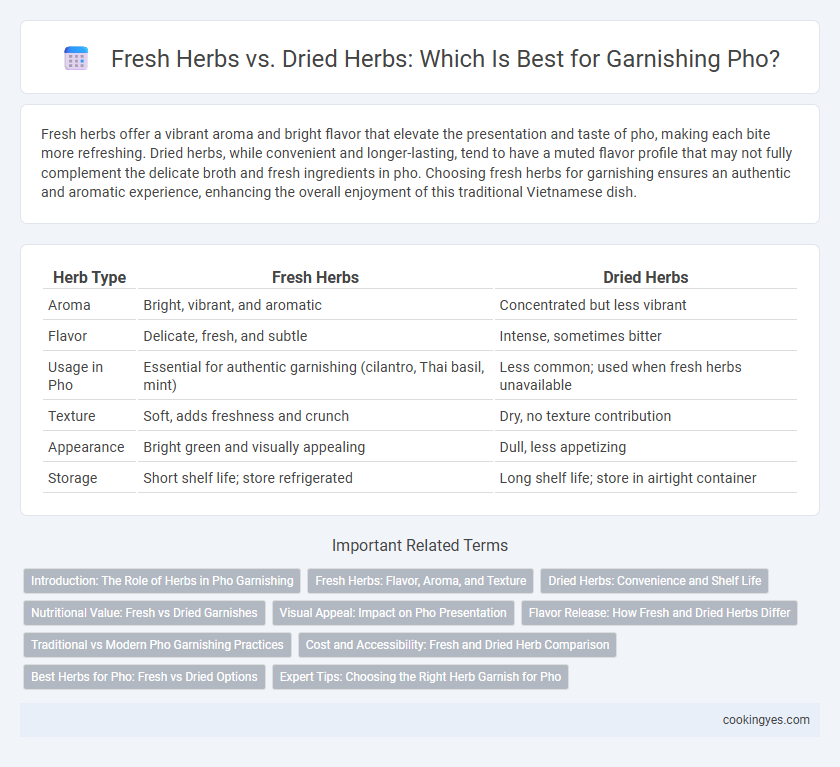Fresh herbs offer a vibrant aroma and bright flavor that elevate the presentation and taste of pho, making each bite more refreshing. Dried herbs, while convenient and longer-lasting, tend to have a muted flavor profile that may not fully complement the delicate broth and fresh ingredients in pho. Choosing fresh herbs for garnishing ensures an authentic and aromatic experience, enhancing the overall enjoyment of this traditional Vietnamese dish.
Table of Comparison
| Herb Type | Fresh Herbs | Dried Herbs |
|---|---|---|
| Aroma | Bright, vibrant, and aromatic | Concentrated but less vibrant |
| Flavor | Delicate, fresh, and subtle | Intense, sometimes bitter |
| Usage in Pho | Essential for authentic garnishing (cilantro, Thai basil, mint) | Less common; used when fresh herbs unavailable |
| Texture | Soft, adds freshness and crunch | Dry, no texture contribution |
| Appearance | Bright green and visually appealing | Dull, less appetizing |
| Storage | Short shelf life; store refrigerated | Long shelf life; store in airtight container |
Introduction: The Role of Herbs in Pho Garnishing
Fresh herbs such as cilantro, Thai basil, and mint play a crucial role in pho garnishing by enhancing the broth's aromatic complexity and adding vibrant, fresh flavors. Dried herbs lack the bright, crisp texture and intense aroma that fresh herbs provide, which are essential for achieving the authentic sensory experience of traditional pho. The use of fresh herbs not only elevates the dish's flavor profile but also contributes to its visual appeal, making each bowl of pho both flavorful and inviting.
Fresh Herbs: Flavor, Aroma, and Texture
Fresh herbs in pho deliver vibrant flavor, aromatic intensity, and crisp texture that dried herbs cannot replicate. Basil, cilantro, and mint retain essential oils that explode with fragrance and enhance the overall sensory experience of pho. Their moisture content also adds a refreshing contrast to the rich, savory broth, elevating each bowl's authenticity and taste complexity.
Dried Herbs: Convenience and Shelf Life
Dried herbs offer significant convenience for garnishing pho due to their extended shelf life and easy storage, maintaining flavor stability over time. Unlike fresh herbs, dried varieties can be stocked in advance and used without frequent replacement, making them ideal for consistent seasoning. Their concentrated flavor also allows small quantities to enhance the aromatic profile of pho without overwhelming the broth.
Nutritional Value: Fresh vs Dried Garnishes
Fresh herbs like cilantro and Thai basil used in pho retain higher levels of vitamins A, C, and K compared to their dried counterparts, which lose significant nutrients during dehydration. The antioxidants in fresh herbs contribute to pho's health benefits by supporting immune function and reducing inflammation. Dried herbs may offer concentrated flavors but lack the same nutritional potency essential for a nutrient-rich garnish.
Visual Appeal: Impact on Pho Presentation
Fresh herbs such as cilantro, Thai basil, and mint provide vibrant colors and lively textures that enhance the visual appeal of Pho, making the dish look more appetizing and authentic. Dried herbs lack the bright green hues and fresh appearance, often resulting in a duller and less enticing presentation. The contrast between bright fresh herbs and the rich broth is essential for an inviting Pho presentation that stimulates the senses before tasting.
Flavor Release: How Fresh and Dried Herbs Differ
Fresh herbs in pho release vibrant, aromatic oils when added just before serving, enhancing the dish's bright, complex flavor profile. Dried herbs, often used in broths or marinades, provide a more concentrated, subtle taste that infuses slowly during cooking. The difference lies in fresh herbs delivering immediate, intense freshness, while dried herbs contribute depth and warmth over time.
Traditional vs Modern Pho Garnishing Practices
Traditional pho garnishing relies heavily on fresh herbs such as Thai basil, cilantro, and sawtooth coriander, which enhance the soup's aromatic complexity and authentic flavor profile. Modern pho preparations sometimes incorporate dried herbs for convenience and longer shelf life, though these may lack the vibrant taste and texture delivered by fresh varieties. Fresh herbs provide essential oils and bright notes that define traditional pho, making them preferred for an authentic culinary experience.
Cost and Accessibility: Fresh and Dried Herb Comparison
Fresh herbs for garnishing pho offer vibrant flavor and aroma but tend to be more expensive and less accessible in some regions, especially out of season. Dried herbs provide a budget-friendly, longer-lasting alternative that is widely available year-round but lack the bright, fresh taste essential to authentic pho experience. Considering cost and accessibility, dried herbs suit occasional use, while fresh herbs are preferred by enthusiasts seeking optimal flavor.
Best Herbs for Pho: Fresh vs Dried Options
Fresh herbs like Thai basil, cilantro, and mint are essential for authentic pho, offering vibrant flavors and aromatic freshness that dried herbs cannot replicate. While dried versions can be convenient and have a longer shelf life, they lack the bright, crisp taste critical for garnishing pho bowls. For the best pho experience, prioritize fresh herbs to enhance the broth's complex flavors and create a balanced, flavorful dish.
Expert Tips: Choosing the Right Herb Garnish for Pho
Fresh herbs such as Thai basil, cilantro, and mint provide vibrant flavors and aromatic freshness essential for authentic pho, while dried herbs lack the potency and crisp texture needed for proper garnish. Experts emphasize selecting fresh herbs with bright green leaves and avoiding wilted or discolored bunches to enhance pho's visual appeal and taste. Using fresh herbs immediately before serving ensures maximum flavor impact and preserves the traditional pho experience.
Fresh herbs vs dried herbs for garnishing Infographic

 cookingyes.com
cookingyes.com